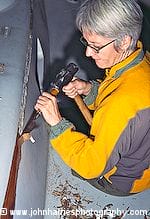I’m going to make a confession here: I think brightwork is beautiful. However, since I’m the one that ends up maintaining it—that’s because John insists I’m so much better at it than he is, which is a rotten trick and one I fall for regularly—I also believe it doesn’t belong on our boat.

In fact, I’ve spent hours communing with a maul and slick (big chisel) removing extraneous expanses of it (eyebrows). Those bits that I can’t remove without leaving gaping holes I have covered with white paint that only needs spiffing up every three years instead of every three months.
At this point, the only exterior brightwork left on Morgan’s Cloud is a few bits in the cockpit and that’s because John threw himself bodily in front of them when I went for them with the slick. So, until we get an unpainted aluminum boat with no exterior wood anywhere, I guess I’m going to be varnishing and painting.
While spending the last several years at Billings Diesel and Marine in Stonington, Maine, where we are refitting Morgan’s Cloud, we’ve garnered a few tips from the professionals; in my reluctant case, from the guys in the Paintshop:
- If the paint or varnish pulls (is hard to drag across the surface), add minute amounts of thinner (i.e. less than a capful at a time) just until the brush runs smoothly.
- Foam brushes are useless—they don’t hold enough paint and varnish and so lay on an uneven and thin coat; which means you’ll have to varnish or paint more often (shudder).
- Drill a hole in the base of the brush handle so that, after use, the brush can hang from a wire through the hole, so that the hairs of the brush don’t touch the bottom of the container of thinner—the brush will keep its shape and suppleness for much longer.
 And, most important of all, the best sandpaper comes in rolls with a sticky back: Norton A275, 2-3/4” wide by 45 yards long. Though designed to be stuck on to sanding boards, if you cut off a suitable length of the required grit and fold it in half so the glued sides stick together, you can make a piece the size and shape you want that won’t crumple or tear. Since the quality of the grit is so good, the paper is very thin and therefore can fit into much smaller spaces than folded sheets or blocks. The bad part is that once you have the sandpaper all cut and glued you then have to actually do the sanding—sigh.
And, most important of all, the best sandpaper comes in rolls with a sticky back: Norton A275, 2-3/4” wide by 45 yards long. Though designed to be stuck on to sanding boards, if you cut off a suitable length of the required grit and fold it in half so the glued sides stick together, you can make a piece the size and shape you want that won’t crumple or tear. Since the quality of the grit is so good, the paper is very thin and therefore can fit into much smaller spaces than folded sheets or blocks. The bad part is that once you have the sandpaper all cut and glued you then have to actually do the sanding—sigh.


Hi, I do a lot of glossing of woodwork in houses, cleaning brushes out with spirit at the end of the day is a mug’s game.
I use a product called “Brush Mate”. It’s a box with some clips for brushes and a pad with some special solvent in it. Put a brush in there and the paint doesn’t dry! Even better is that over the course of a day as the paint higher up on the brushes starts to thicken, just pop the brush in the box, pull out another and carry on, the brush in the box gets softened and rejuvenated in the solvent atmosphere. I like to have two brushes on the go, a wide one and a tiny thin one for little corners; simply keep the one you’re not using in the tub.
According to the manufacturers the solvent only works for paints using white spirit as a solvent so some special boat varnishes may not be ok. It looks like I’ve a fair bit of internal varnishing (boat) to do so will be cleaning out any gloss paint residue from my tub and using it for that this summer.
I also buy professional sandpaper on a roll. It’s not cheap but having an endless supply there means that as a piece gets a bit bare or clogged you don’t hesitate to rip off another bit and carry on doing a good job.
Cheers, Dave
Ps I don’t work for Brush Mate, I just rate their product.
If I’m doing a multiday varnish or paint job, I wrap the brush I Saran wrap and put it in the freezer, no clean up. Brush needs to stay in plastic wrap for a while when it comes back out due to condensation.
Hi Brian,
now there’s a great idea.